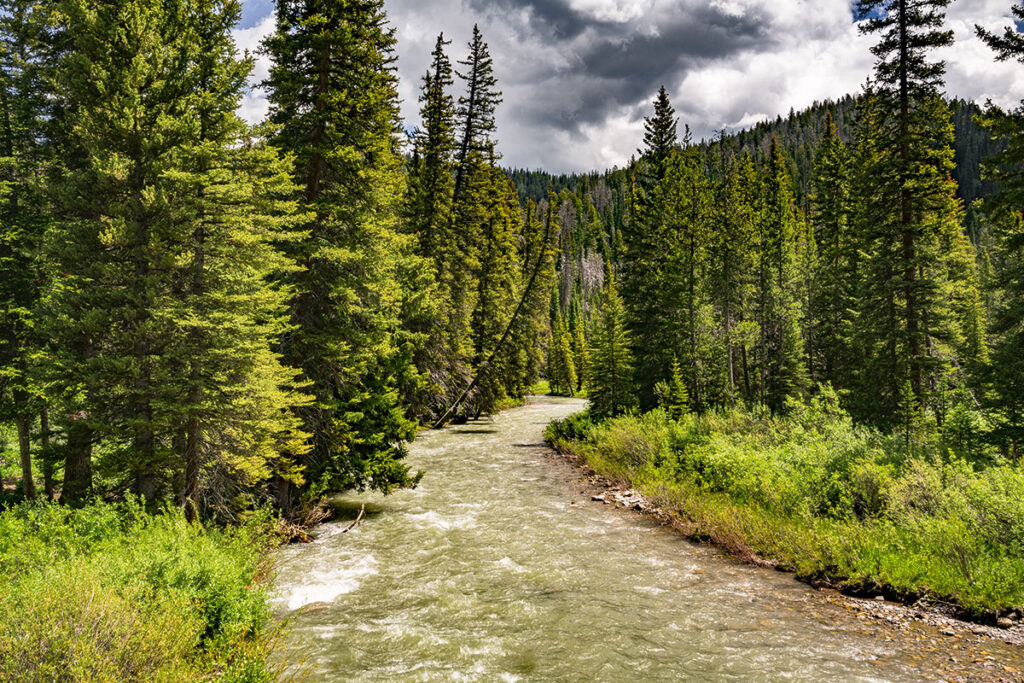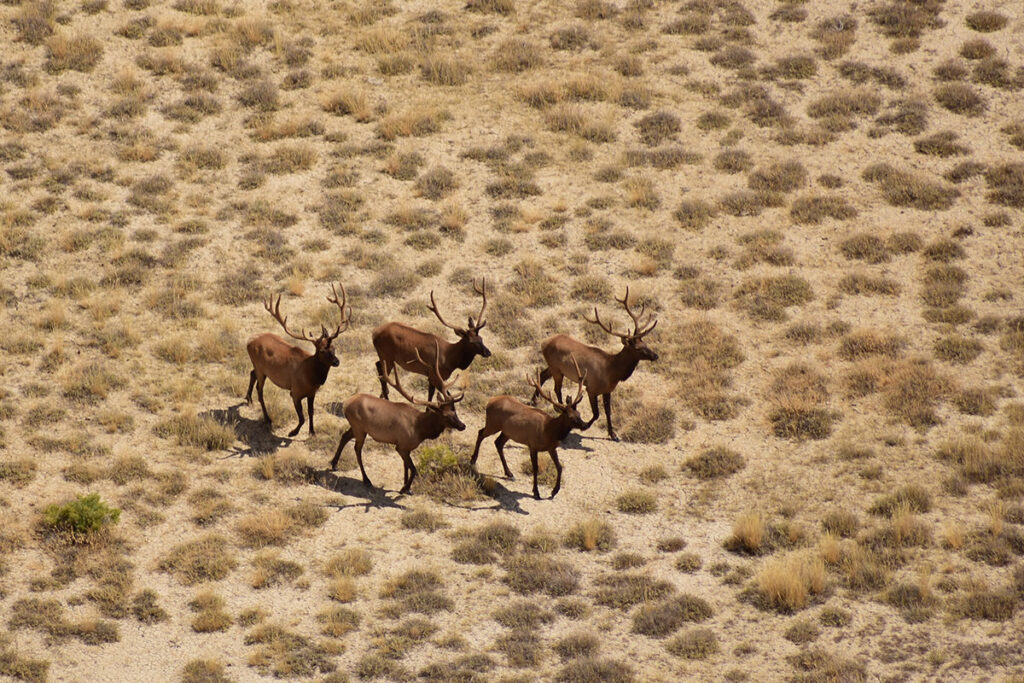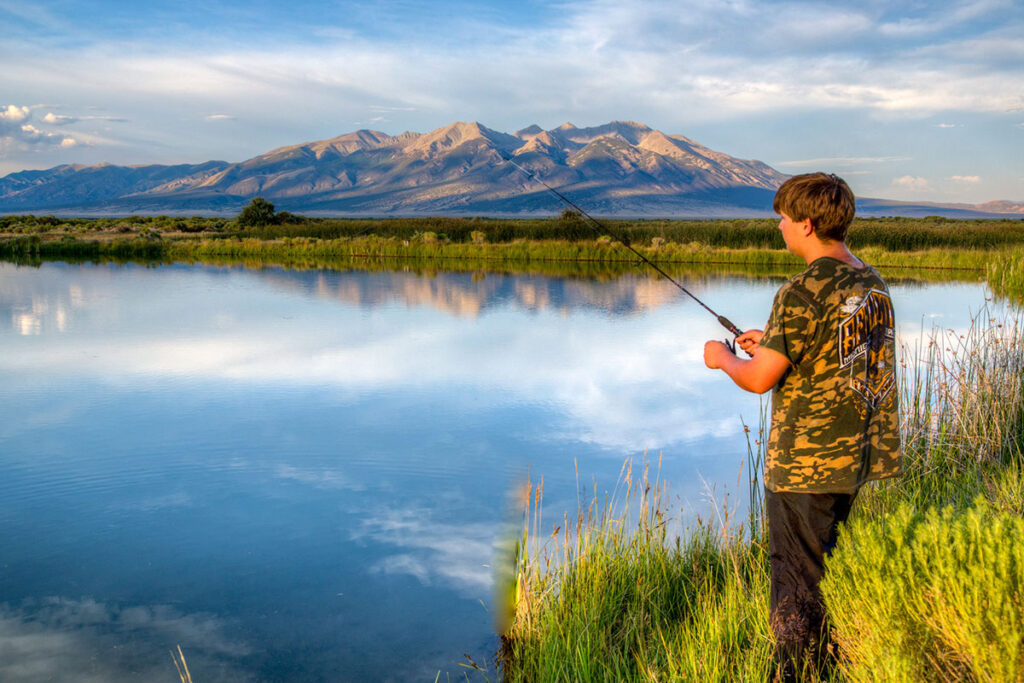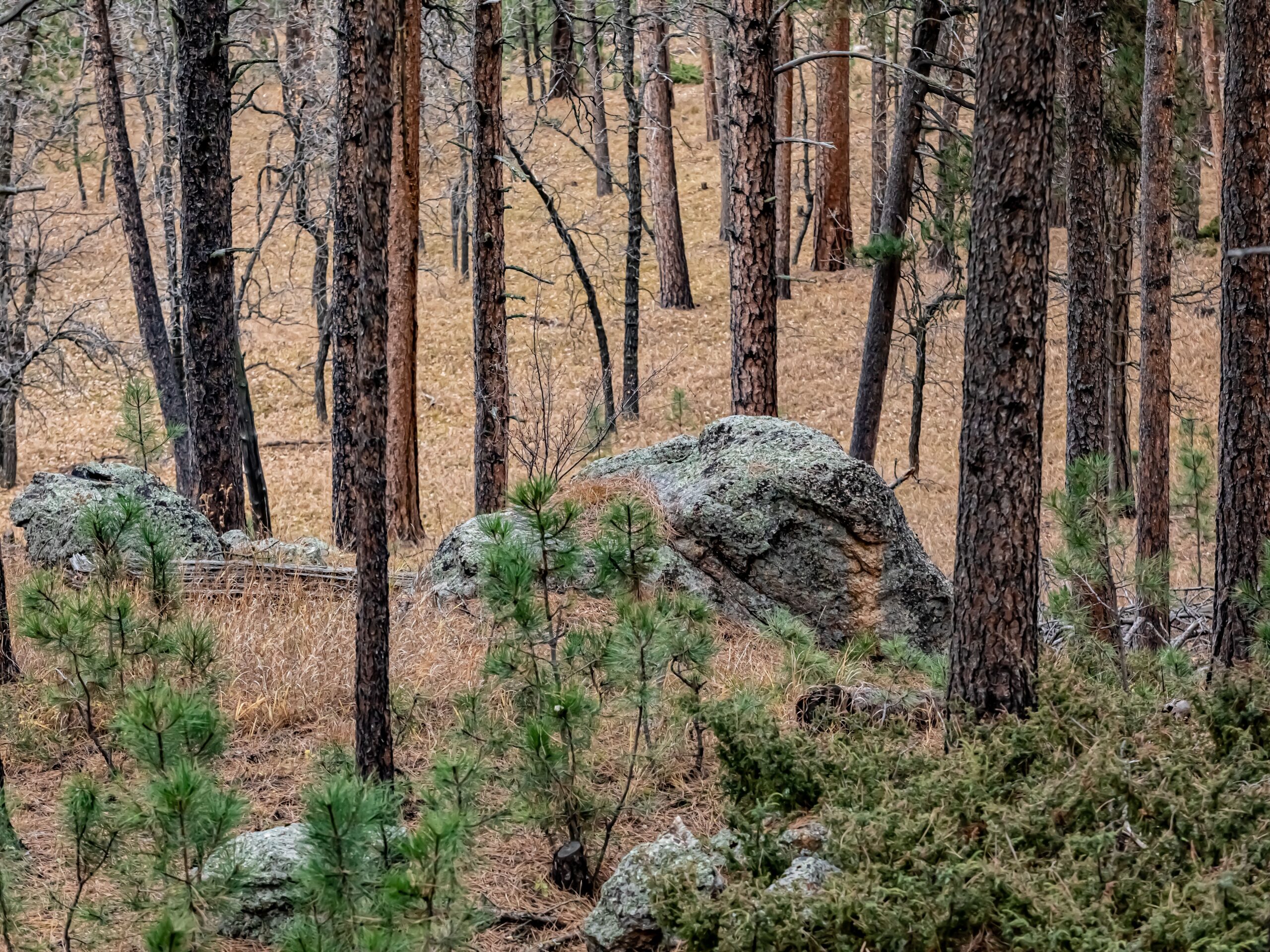Highlights
- State trust lands are managed under a unique legal framework that imposes a fiduciary responsibility on states to generate long-term, sustainable revenue for trust beneficiaries, primarily public schools.
- Historically, these lands generated revenue through traditional natural resource leases such as livestock grazing, timber harvesting, and energy development. While these traditional uses continue to be the major economic drivers in many states, outdoor recreation, tourism, and conservation have become increasingly valuable and offer new opportunities for states to earn income from state trust lands.
- Realizing the full potential of conservation use on state trust lands requires addressing remaining challenges and exploring opportunities for optimal expansion. Some of the major challenges include exclusive focus on traditional land uses, stakeholder resistance to change, and a lack of agency expertise in conservation management.
- Innovative approaches such as conservation leasing and licensing, tailored easements, and strategic land exchanges are being implemented by some states, demonstrating the potential to optimize revenue generation with long-term land conservation and highlighting the need for continued adaptation in trust land management. Yet many states have not yet fully embraced such strategies despite the fiduciary necessity of doing so.
Key Takeaways
- In fulfilling their fiduciary obligation as trustees, states should strive to optimize both immediate revenues and long-term land value of state trust land through a diversified portfolio approach, considering both traditional revenue sources and emerging opportunities, including conservation use opportunities.
- Conservation use of state trust lands can generate current income while preserving the future economic potential of the land. This approach aligns with the perpetual nature of state land trusts and addresses intergenerational equity by ensuring that both current and future generations can benefit from these lands.
- To capitalize on emerging opportunities, states can either create separate conservation leasing processes or modify rules that limit participation, such as those that pre-determine certain uses or impose “use-it-or-lose-it” requirements.
- States that fail to consider diverse land uses, including conservation, may face legal challenges. Cases in Idaho and Arizona have demonstrated that policies prioritizing specific uses of state trust land without considering higher-revenue alternatives can violate fiduciary duties. Courts have shown a willingness to enforce states’ obligations to maximize long-term returns, potentially invalidating practices that exclude competitive conservation proposals.

Introduction
State trust lands form a significant portion of the landscape in the American West, with approximately 40 million acres spread across 11 western states.1Jillian Jurica, Demystifying State Trust Lands: History & Interactive Guide of Access Regulations & Allowed Activities, OnX Maps (Oct. 7, 2022), https://www.onxmaps.com/blog/state-trust-land-history
-regulations-activities-and-more. These lands were granted to the states by the federal government in the late 1800s and early 1900s when states entered the Union.2See Ctr. on Educ. Pol’y, Public Schools and the Original Federal Land Grant Program: A Background Paper from the Center on Educational Policy 5 (2011), https://files.eric.ed.gov/fulltext/ED518388.pdf. States were given these lands to generate revenue for designated beneficiaries, primarily public schools.3Id. at 3 (stating that trust lands were granted to new states for the support of their public institutions including public schools and universities, prisons, hospitals, military institutions). Over time, this responsibility has evolved into a formal trust arrangement, with states acting as trustees.
Historically, state trust lands have generated revenue primarily through leases for activities such as livestock grazing, mining, oil and gas drilling, and timber harvesting, as well as through land sales. As markets for traditional extractive uses shift and public values evolve, however, states are increasingly recognizing the need or opportunity to adapt and diversify their strategies for generating income from trust lands. The current challenge for state trust land managers is to develop and maintain a diversified portfolio that can generate long-term, sustainable benefits for current and future trust beneficiaries.4Memorandum from Tobin Follenweider, WSLCA Asset Mgmt. Comm. Chair, to WSLCA Members, 3, 7 (Sept. 14, 2016), https://www.statetrustland.org/uploads/1/2/0/9/120909261/wslca-principles-of-state-trust-portfolio-management.pdf (explaining that intergenerational equity requires that “[t]he trustees of endowed institutions are the guardians of the future against the claims of the present. Their task in managing the endowment is to preserve equity among generations.”). This likely requires balancing continued reliance on traditional commodity-based income sources with the embrace of new opportunities aligned with changing economic realities. Conservation use of state trust land, in its various forms, presents a promising new avenue to generate additional income, enabling trust managers to fulfill their fiduciary duty to beneficiaries while simultaneously preserving and enhancing the value of the trust assets.
By preserving open spaces and diverse landscapes, conservation use can expand opportunities for outdoor recreation, such as hiking, biking, and bird watching, and to generate income from these activities.
Conservation use of state trust land can be broadly defined to include conservation leases and licenses, conservation easements, and other conservation-oriented land sales, transfers, and exchanges. Conservation use provides for the opportunity to conserve land and resources through non-extractive use while still generating revenue.5See generally Bryan Leonard, Shawn Regan, Christopher Costello, Suzi Kerr, Dominic P. Parker, Andrew J. Plantinga, James Salzman, V. Kerry Smith & Temple Stoellinger, Allow “Non-use Rights” to Conserve Natural Resources, 373 Science 958 (2021). In contrast to traditional revenue-generating activities or real-estate development, conservation use involves deriving economic value from protecting and enhancing habitat, open space, and other environmental amenities.
By preserving open spaces and diverse landscapes, conservation use can expand opportunities for outdoor recreation, such as hiking, biking, and bird watching, and to generate income from these activities. Additionally, maintaining intact habitats supports healthy wildlife populations, which can lead to improved opportunities for hunting and wildlife viewing. Moreover, conservation use often involves active habitat restoration efforts, such as controlling invasive species like cheatgrass and modifying fences to facilitate wildlife movement. These restoration activities not only improve ecosystem health but also enhance recreational and hunting experiences.
Some states have been hesitant to fully embrace conservation uses of trust lands, questioning whether such practices could be consistent with their revenue-maximization mandates and other trust obligations, while also expressing concern about potential competition with existing traditional land uses. Despite these concerns, a growing number of states recognize the potential of conservation use and are actively developing new mechanisms and strategies to expand such opportunities on state trust lands.
Realizing the full potential of conservation use across all state trust lands requires addressing remaining challenges and exploring opportunities for optimal expansion. This policy brief addresses these issues by exploring four key areas. First, it examines the unique legal status of state trust lands, which establishes the foundation for understanding conservation use constraints and opportunities. Next, it considers the economics of state trust lands, focusing on the effectiveness of the trust model in producing financial returns and highlighting the need for adapting to changing economic dynamics while maintaining the principle of intergenerational equity. Then it discusses the remaining challenges and questions surrounding conservation use on state trust lands. Lastly, the brief provides an overview of existing and emerging conservation use mechanisms and policies, highlighting successful examples and innovative approaches.
The brief concludes with key considerations for state land managers and policymakers on optimizing state trust land management via conservation use, emphasizing how this approach can help meet fiduciary duties. By addressing these critical aspects, this brief aims to contribute to the ongoing dialogue on the role of conservation use in sustainable state trust land management and the fulfillment of associated trust requirements.

A Unique Legal Framework
State trust lands, established through enabling acts as new states joined the Union, represent a unique category of public lands with a rich historical legacy. Guiding their management is the trust mandate, a fundamental principle rooted in these enabling acts, which shapes decision-making and balances revenue generation with evolving land use priorities. The following section delves into both the rich history of these lands and the pivotal role of the trust mandate in shaping their management.
The Origin of State Trust Lands
After the Revolutionary War, the federal government began granting western lands to newly formed states to support public education and encourage western settlement.6See Ctr. on Educ. Pol’y, supra note 2, at 5 (stating “there was already general consensus in favor of using the ‘public bounty’ for the support of common schools” as opposed to new taxes). Key federal laws such as the 1785 Land Ordinance and 1789 Northwest Ordinance laid out processes for surveying federal lands and admitting new states, requiring the encouragement of public education. When Ohio became a state in 1803, for example, it was granted one section (640 acres, or one square mile) per township (a square unit of land comprising 36 sections) to fund schools.7Jon A. Souder & Sally K. Fairfax, State Trust Lands: History, Management, and Sustainable Use 22-24 (1996). Over time, Congress granted more lands to newly admitted states—typically sections 16 and 36 in each township, and, later, sections 2 and 32 as well.8See Ctr. on Educ. Pol’y, supra note 2, at 11.
In total, the federal government granted 77.6 million acres of land to the states for the purpose of supporting public education.9Id. at 3 (citing David Tyack, Thomas James & Aaron Benavot, eds., Law and the Shaping of Public Education, 1785-1954 (1987)). Many states, particularly those established before 1850, sold off a significant portion of their granted lands, leaving 46 million acres remaining in state ownership today.10See Jurica, supra note 1. Congress did not initially authorize the sale of granted lands.11Sally K. Fairfax, Jon A. Souder & Gretta Goldenman, The School Trust Lands: A Fresh Look at Conventional Wisdom, 22 Env’t. L. 797, 807 n. 25 (1992). However, recognizing that leasing state trust land was not always viable when abundant free federal land was available, Congress eventually allowed states to sell trust lands.12Id. at 821.
While some early state policies encouraged the sale of trust lands to generate revenue and promote settlement, states have since shifted their focus toward retaining these lands. For instance, California, which joined the Union in 1850, currently holds only 10 percent of its original granted lands.13Ctr. on Educ. Pol’y, supra note 2, at 14 In contrast, states that joined the Union later have retained most of their granted lands, likely reflecting the national policy shift from land disposition to retention.14See id at 15. As a result, states such as Arizona, Montana, and Wyoming still hold 80 percent of their originally granted lands.15Id.
While granting land to the states was straightforward, managing the land effectively proved to be a complex challenge. To prevent the waste of trust assets, Congress added specific prescriptions to state enabling acts, including price restraints, and detailed rules for selling and leasing the lands.16Id. at 14 States also began establishing permanent funds for the proceeds from some school land leases and sales, a practice Congress later required.17Id. at 12-13. Congress also introduced “in lieu” grants, allowing states to select alternative sections of land if the designated sections had been sold, fell within a federal reservation, or were otherwise disposed of, and provided additional grants to states for infrastructure, territorial governments, colleges, and mineral rights.18Id. at 12.
The Trust Mandate
State trust lands are unique among public resources due to their specific purpose: supporting public schools and other named beneficiaries in perpetuity.19See Souder, supra note 7, at 1. This purpose, established at statehood, imposes a fiduciary responsibility on states to generate long-term, sustainable revenue from either the use or sale of these lands.20See id. at 1–2. Over time, the management of state trust lands and their revenue evolved to be legally recognized and interpreted as a trust responsibility, with states acting as trustees.21See id. The notion that the federal government intentionally created trust obligations in early state enabling acts is disputed. See Fairfax et al., supra note 11, at 809. Instead, the creation of trusts in early states arose implicitly from commitments made in state constitutions or statutes. Id. It wasn’t until the admission of New Mexico and Arizona to the Union in 1910 that Congress began to intentionally use language creating a trust in enabling acts for new states. See, e.g., Peter W. Culp, Andy Laurenzi, Cynthia C. Tuell & Alison Berry, State Trust Lands in the West: Fiduciary Duty in a Changing Landscape 12 (2015), https://www.lincolninst.edu/app/uploads/legacy-files/pubfiles/state-trust-lands-in-the-west-updated-full.pdf. Today, all western states except California recognize some form of trust responsibility associated with their state lands. Id. at 13.
As trustees, state trust land managers have key duties rooted in foundational trust principles: acting in good faith for designated beneficiaries, exercising prudence in asset management, and preserving trust assets for future generations.22See Culp et al., supra note 21, at 25–26. In fulfilling these duties, managers face a complex challenge in balancing short-term revenue generation with long-term asset preservation, a tension inherent in their dual mandate to maximize current returns while ensuring the perpetual existence of the trust.23See Memorandum from Tobin Follenweider, supra note 4, at 3. This balancing act manifests in two competing aspects of their fiduciary duty. On one hand, the fiduciary obligation may lead some managers to pursue strategies that maximize the greatest immediate financial return. On the other hand, fiduciary prudence dictates that managers must weigh returns not just for current beneficiaries but for successive generations as well, necessitating protection of the underlying resource base and asset value.
This tension between short-term gains and long-term sustainability has not gone unnoticed by the courts. In fact, courts have increasingly recognized that the most important characteristic of state land trusts is their perpetual nature.24See Culp et al., supra note 21, at 30. Consequently, state land trust managers are expected to balance immediate revenue maximization with intergenerational equity.25See id. While courts emphasize that states should seek fair market value when leasing or selling trust lands, the challenge of balancing various trust obligations is evident in the persistence of some below-market leases.
The fiduciary duty associated with state trust lands, however, is unique compared to traditional trust duties. This uniqueness arises from the fact that, unlike a typical trustee, states are simultaneously a trustee and a government entity.26See id. at 27-28. As a result, state trust lands remain subject to general state laws and regulations, such as environmental protection laws.27See id. at 28. Moreover, states have the power, subject to conflicting federal law, to pass laws that specifically regulate state actors’ behavior as trustees.28See id. at 27-28. This dual role as both trustee and government creates a complex legal and political environment for the management of state trust lands, requiring states to square their broader governmental responsibilities with their trust obligations.

Economic Dynamics of State Trust Lands
Across states, trust lands are leased for a variety of revenue-generating activities, including grazing, agriculture, timber harvesting, mineral and energy resource extraction, commercial development, and recreation. State trust lands primarily generate revenue through royalties from non-renewable resource extraction, usually oil, gas, and coal; sales of trust lands; and fees from renewable resource use including agriculture, grazing, timber, commercial leases, and surface rentals for mineral extraction.29See id. 17. Grazing remains the most common use of state trust land, while mineral and energy production and land sales generate the most revenue.30Steven M. Davis, Preservation, Resource Extraction, and Recreation on Public Lands: A View from the States, 48 Nat. Res. J. 303, 330 (2008).
State trust lands have historically been managed quite differently than federal U.S. Forest Service and Bureau of Land Management lands, which are subject to multiple use mandates.31See Federal Land Policy and Management Act of 1976 (FLMPA), 43 U.S.C. § 1701; Multiple-Use Sustained Yield Act of 1960 (MUSYA), 16 U.S.C. § 528. Instead, consistent with their fiduciary duty to maximize revenues for beneficiaries, state trust lands have traditionally been subjected to more intensive activities compared to federal lands, resulting in great financial returns to trust agencies. For example, in a 2008 study, Steven Davis found that the 600 million acres of federal public land generated an average of $1.29 billion in gross annual revenue. In contrast, state trust lands, which comprise approximately one-sixth the acreage of federal lands, generated an average of $4.5 billion annually.32Id. at 330. This equates to roughly 15 times more revenue per acre on state trust land compared to federal public lands.
Additionally, a 2015 analysis by PERC researchers on the differences between state and federal land management found that state trust agencies produce far greater financial returns than federal agencies.33See Holly Fretwell & Shawn Regan, Divided Lands: State vs. Federal Management in the West 4 (2015), https://www.perc.org/wp-content/uploads/2015/03/150303_PERC_DividedLands.pdf. Specifically, they found that state lands in Arizona, Idaho, Montana, and New Mexico generated an average of $14.51 per dollar spent on land management, while the U.S. Forest Service and Bureau of Land Management generated only 73 cents per dollar spent.34Id. These stark differences in revenue generation and financial efficiency underscore the distinct management priorities and approaches between state trust lands and federal public lands, with state trust lands prioritizing revenue generation for beneficiaries over multiple use objectives.
As markets for traditional extractive uses shift and public values evolve, states are increasingly recognizing the need or opportunity to adapt and diversify their strategies for generating income from trust lands.
Revenues generated from the use and sale of state trust lands are often managed through a combination of permanent funds and direct distributions.35See Fairfax et al., supra note 11, at 837. Many states deposit a significant portion into permanent accounts and distribute the interest or a portion of the fund’s earnings to beneficiaries annually, while specific practices vary by state.36Id. at 838. The size of these permanent funds varies significantly among states. For example, New Mexico and Wyoming have substantial permanent funds, primarily due to oil, gas, and coal royalties.37Id. Similarly, Arizona’s sizable permanent fund is the result of profitable land sales near urban areas.38Id. In contrast, states with smaller permanent funds may have either sold a significant portion of their granted lands early for low prices or may have limited revenue-generating opportunities.39Id. at 839 (stating that the difference in states’ permanent trust funds is “due to two factors: the amount of lands sold for low prices in the early days of statehood; and the amount of mineral royalty income accruing to the permanent fund”). Revenues from renewable resources on state trust lands, such as leases for timber, agriculture, and grazing, are often managed differently from non-renewable resource revenues. In many states, renewable resource revenue may be more likely to go directly into accounts for near-term use by beneficiaries, though specific practices vary by state and resource type.
While natural resource commodity uses continue to be major economic drivers in many western states, outdoor recreation and tourism have become increasingly valuable and offer new economic opportunities.40See Catherine Traywick & Hannah Recht, American West Discovers How to Make Money on the Outdoors: Enjoy It, Bloomberg (Mar. 2, 2019), https://www.bloomberg.com/graphics/2019-western-outdoor-economy/. Since the late 20th century, traditional resource industries, particularly grazing and timber harvesting, have declined in their relative importance for local economies across much of the West.41ee Dan S. Rickman & Hongbo Wang, Whither the American West Economy? Natural Amenities, Mineral Resources and Nonmetropolitan County Growth, 65 Annals Reg’l Sci. 673, 693 (2020). According to research by Headwaters Economics, a nonprofit research group that studies the changing economy of the American West, the region has undergone a significant economic transition in recent decades, in some locations shifting away from traditional resource-extraction industries and toward a more diverse, service-based economy driven by natural amenities and quality of life factors.42See Michael Tolan, Outdoor Recreation & Economic Diversification in Resource-Dependent Communities, Headwaters Econ. 7 (June 2022), https://headwaterseconomics.org/outdoor-recreation/diversifying-natural-resource-dependence.
The burgeoning outdoor recreation and tourism sectors in the West present new economic opportunities and challenges for state trust land managers. Conservation leasing is emerging as an innovative approach that can generate revenue while preserving ecological values, offering a potential bridge between economic and environmental objectives. The stark contrast in revenue generation between state trust lands and federal public lands underscores the effectiveness of the trust model in producing financial returns. Future success will likely depend on striking a balance between traditional revenue sources and emerging economic opportunities, all while maintaining the core principle of intergenerational equity that underpins the state trust land model.

Legal and Political Challenges
State trust lands are governed by a complex array of constitutional, statutory, and administrative restrictions that dictate how these lands can be used and managed. Many of these restrictions were put in place decades ago, when the economic landscape of the region was vastly different than it is today. As the economy of the West evolves, however, some of these restrictions may no longer be as well-suited to current circumstances and needs as they once were.
Conservation use of state trust lands presents a unique opportunity to preserve natural amenities that attract tourists and outdoor enthusiasts, enabling these lands to tap into the West’s growing recreation and tourism economy while maintaining long-term value. Additionally, it allows managers to access conservation funding and financing mechanisms that private landowners have successfully leveraged, potentially opening up new revenue streams and resources for land management. However, many managers find themselves constrained by outdated structures that limit their ability to adapt to these changes and capitalize on conservation-based opportunities. Several factors contribute to this challenge:
Exclusive Focus on Traditional Uses
Many state trust land policies remain oriented toward traditional extractive industries, often lacking the flexibility to accommodate or even consider conservation use opportunities. This absence of dedicated conservation options forces conservation-oriented users to participate in markets designed for other uses, where they frequently encounter additional barriers incompatible with their goals. For instance, “use-it-or-lose-it” requirements in traditional leases often conflict with conservation objectives that prioritize minimal land disturbance. Wyoming, for instance, disqualifies anyone from bidding on a grazing lease if they do not have “actual and necessary use of the land for the production of agricultural commodities.43Wyo. Stat. Ann. § 36-5-105(j) (2023). In forested areas, some states may offer timber leases only with requirements to harvest a percentage of timber within a specific timeframe.44See, e.g., 060-0002-8 Wyo. Code R. § 9–10 (1998) (imposing bond and fee requirements premised on the assumption that timber will be removed from leased forested land).
These policies inadvertently limit the participation of environmental groups in state trust land revenue generation, potentially overlooking lucrative conservation markets and restricting managers’ ability to explore diverse income streams. The Idaho and Arizona Supreme Courts have independently found that such policies violate state fiduciary obligations by privileging some uses over others without regard to the potential revenue that will be returned to beneficiaries.45See Idao Watersheds Project v. State Bd. Land Comm’rs, 982 P.2d 367 (Idaho 1999); Forest Guardians v. Wells, 34 P.3d 364 (Ariz.2001) (en banc). State trust management approaches that balance traditional commodity uses with flexibility to explore new revenue-generating opportunities better fulfill fiduciary obligations. While states can continue to focus on established commodity uses, they should also create mechanisms to participate in emerging markets like conservation use. This approach would allow trust land managers to diversify income streams, potentially increasing overall revenue for beneficiaries while still maintaining traditional uses.
Leasing Structures that Disfavor Conservation
Existing lease structures are often tailored to specific uses such as grazing, mining, and timber harvesting and are not well-suited for conservation-based recreation and tourism ventures. For example, the pricing structure for an oil and gas lease—which includes royalty payments tied to production of the resource—may not be appropriate for a conservation lease that aims to preserve natural amenities. This mismatch complicates comparisons between conservation proposals and traditional-use bids.
Additionally, conservation users may have difficulty complying with extracurricular obligations sometimes included in traditional lease agreements, such as timber lease requirements to reduce wildfire risk or develop and maintain roads. While a conservation lease could potentially compensate the state for the loss of such additional benefits, these provisions are often presented as mandatory, further complicating the use of existing lease structures for conservation purposes. Some states have overcome these constraints by developing separate conservation leasing systems.
Drive Stakeholder Concerns
Reservations about new applications for state trust lands, especially conservation-oriented ones, remain. Concerns primarily come from three sources: 1) existing resource users, 2) resource-dependent communities, and, somewhat surprisingly, 3) some conservationists themselves.
Existing resource users may oppose conservation leasing because they fear it will raise their cost of doing business by introducing more competition at the bidding table. Resource-dependent communities, including input suppliers (e.g., feed stores, equipment dealers), output processors (e.g., mills, slaughterhouses), and laborers, worry about potential economic losses from reduced natural resource use. In rural areas heavily reliant on ranching, timber harvesting, or conventional energy development—many of which rely, at least in part, on state trust lands—there are concerns that widespread conservation use could lead to a loss of economies of scale and jeopardize traditional industries. Additionally, some conservationists oppose a market-oriented approach to conservation on state trust lands, viewing it as an abdication of the state’s responsibility to protect public resources.
Political resistance creates a challenging environment for state trust land managers, who find themselves caught between their fiduciary duty to generate revenue and the various stakeholders resisting change.
Lack of Expertise, Resources, and Long-Term Planning
Many state land offices lack the expertise, resources, and comprehensive planning necessary to effectively manage, market, and develop conservation-based opportunities on state trust lands. Unlike well-established processes for resource extraction, there are often no dedicated staff or departments focused on developing the potential of conservation use.
As a result of these challenges, state trust land managers often find themselves unable to fully capitalize on the potential of conservation use or tap into growing recreation and tourism sectors. While they are bound by their fiduciary duty to generate revenue for beneficiaries—which requires them to respond to changing market conditions and seize emerging opportunities—they are constrained by a lack of appropriate processes and structures that can make it difficult or impossible to pursue conservation-based recreation opportunities in a timely and effective manner.

Existing Opportunities for Conservation uses
The expanding outdoor recreation and tourism sectors in the West, coupled with growing conservation funding opportunities and shifting consumer preferences toward nature-based experiences, have heightened the potential for state trust lands to generate revenue through conservation-based uses. Although state trust lands are fragmented and comprise a minority of western landscapes, they often provide corridors for wildlife connectivity, critical habitat, and conservation focal points that influence ecosystem function and species viability on a larger scale.46See e.g. Mike Koshmrl, ‘Path of the Pronghorn’ Bottleneck Leased for Development at $19/Acre, WyoFile (July 25, 2023), https://wyofile.com/path-of-the-pronghorn-bottleneck-leased-for-development-at-19-acre/; see also Rob Hotakainen, Wyoming Board Puts Brakes on Plan to Sell Grand Teton Land, E&E News (Dec. 7, 2023, 4:21 PM), https://www.eenews.net/articles/wyoming-board-puts-brakes-on-plan-to-sell-grand-teton-land/.
Recognizing this growing conservation value, several states have begun to explore management approaches that generate novel revenue for trust beneficiaries. These strategies include conservation leasing, conservation easements, and strategic land sales, transfers and exchanges. Various states have already begun to implement conservation-oriented land management techniques to secure returns for their trust lands.
Conservation Leasing
Conservation leases have emerged as a promising tool for state trust land conservation, offering a range of opportunities to protect ecological resources, wildlife, and historical or cultural assets.
Five main types of conservation leases have been developed: 1) traditional conservation leases, 2) conservation licenses, 3) ecosystem services leases, 4) state agency leases, and 5) special use leases. These vary in terms of intended lessees, specific conservation purposes, and duration. Some states, such as Arizona and Idaho, have taken the lead by establishing formal conservation leasing programs. In Arizona, for example, conservation leasing for state trust lands involves submitting a proposal to the Arizona State Land Department, which evaluates it based on alignment with land management goals, revenue potential, and environmental impact.47See Ariz. Rev. Stat. Ann § 37-312 (2017). If multiple proposals are competing, a public auction may be held.48Id. § 37-313. Once awarded, the lease agreement, which can range from 10 to 50 years, formalizes the terms, and the lessee must comply with state regulations while carrying out the conservation activities.49Id. § 37-313(B).
Other states have implemented conservation leasing variations, such as Colorado’s emerging ecosystem service leases for conservation banks and state agency leases for hunting, fishing, and park access.50See e.g., Ecosystem Services, Colo. State Land Bd., https://slb.colorado.gov/lease/ecosystem-services (encouraging the development of ecosystem services project on state trust land including “[e]nvironmental mitigation markets for water” and “[e]nvironmental mitigation markets for biodiversity (wildlife)”); Public Access on Trust Land, Colo. State Land Bd., https://slb.colorado.gov/public-access#:~:text=The%20Hunting%20and%20Fishing%20Access,accessible%20to%20hunters%20and%20anglers.
Conservation Easements
Conservation easements, which are nonpossessory interests in land that allow the easement holder to restrict certain uses of the land to preserve resources in exchange for compensation or tax credits, are emerging as a tool for conserving state trust lands. Conservation easements have been effective in protecting nearly 38 million acres of private land from development and subdivision.51Nat‘l Conservation Easement Database, https://www.conservationeasement.us. However, their application to state trust lands presents opportunities, such as generating substantial revenue for state beneficiaries, and challenges, such as locking in land uses that future generations may want to change or being interpreted as contrary to state land retention policies. As a result, non-perpetual or renewable conservation easements (such as a 20- to 30-year termed easements) may be more suitable for state trust lands compared to the permanent easements commonly used on private land.
An illustrative example of this approach is the Owen Sowerwine conservation area in Montana.52See Thank You for Helping to Conserve Owen Sowerwine, Flathead Land Tr., https://www.flatheadlandtrust.org/conserve-owen-sowerwine/. Initially, the Montana and Flathead Audubon Societies, along with Flathead County, implemented two consecutive conservation leases to protect the area’s ecological value.53See id.; see also Micah Drew, Owen Sowerwine Natural Area Granted Permanent Conservation Easement, Flathead Beacon (Dec. 18, 2023), https://flatheadbeacon.com/2023/12/18/owen-sowerwine-natural-area-granted-permanent-conservation-easement/. Subsequently, the Montana Land Board approved a perpetual conservation easement for the land, which was specifically permitted by statute.54Mont. Code Ann. § 77-2-101(1)(e)(iii) (2023).
Some states have implemented regulations governing who can hold conservation easements on state trust lands. Montana, for instance, limits this right to the Department of Fish, Wildlife, and Parks and certain non-profit organizations.55Id. § 77-2-101(1)(e). The state has also passed legislation explicitly allowing conservation easements on land managed by the Department of Natural Resources and Conservation.56Id. § 77-2-101(1)(e)(i).
Land Sales, Exchanges, and Transfers
Land sales, exchanges, and transfers are the final set of tools available for conserving state trust lands. While most states have mechanisms for selling trust lands, they typically restrict sales to parcels that are difficult to manage, no longer valuable for revenue generation, or require a land banking system to prevent net loss of state land acreage. Some states, like Arizona, have developed conservation-focused land sale initiatives in response to public concerns over the sale of environmentally sensitive trust lands for development.57Hannah Downey, Holly Fretwell & Shawn Regan, Access Divided: State and Federal Recreation Management in the West, 24, https://www.perc.org/wp-content/uploads/2016/04/PLR-Fed-State-Recreation_REVISED.pdf (describing the Arizona Preserve Initiative).
Land exchanges have emerged as a versatile and effective tool for state trust land management, offering multiple benefits that simultaneously address economic, community, and environmental concerns.58John C. Ruple & Robert B. Keiter, The Future of Federal-State Land Exchange, Wallace Stegner Ctr. for Lands, Rsc., and Env’t Publ’n 1, 3 (2014). These exchanges allow states to consolidate fragmented holdings into more manageable units, enhancing administrative efficiency.59See id at 14. They also provide opportunities to exchange undevelopable or less valuable lands while acquiring properties with higher revenue-generating potential. Furthermore, exchanges can facilitate growth for landlocked communities by making suitable lands available for development. When strategically implemented, this approach enables responsible resource development while supporting the conservation of ecologically sensitive landscapes.
Transfers of state trust lands to other state agencies for conservation purposes, such as game management agencies, are less common due to the potential for permanent limitations on revenue generation. When carefully structured, however, such transfers can play a role in a comprehensive land management strategy.
A notable example of a state land program that effectively combines both transfer and exchange mechanisms is Washington’s Trust Land Transfer program, established in 1989.60See Trust Land Transfer, Wash. State Dep’t Nat. Res., https://www.dnr.wa.gov/managed-lands/land-transactions/trust-land-transfer. This program allows for the transfer of state trust lands that have low-income potential for trust beneficiaries but high ecological or social value to other public agencies or non-profit conservation organizations.61Id.
The framework of state trust land conservation is evolving, with states increasingly recognizing and leveraging the ecological and economic value of these lands. Conservation leasing, easements, and strategic land sales, exchanges, and transfers have emerged as promising tools for balancing the dual mandates of revenue generation and responsible land stewardship. These innovative approaches allow state land managers to tap into both conservation funding sources and the burgeoning outdoor recreation and tourism economy of the West.
Yet implementing these conservation strategies is not without challenges. Legal constraints, funding limitations, and the need to balance conservation goals with fiduciary responsibilities continue to influence the pace and extent of adoption across different states. The varying approaches taken by states like Arizona, Colorado, Idaho, Montana, and Washington demonstrate both the potential for innovation and the complexities involved in developing effective conservation programs for trust lands.
While significant progress has been made, there remains ample opportunity for states to further develop and refine their conservation strategies. By learning from successful models, addressing persistent challenges, and remaining responsive to evolving environmental and economic needs, state trust land managers can continue to enhance their ability to generate sustainable revenue while preserving vital natural resources for future generations.

Conclusion
The unique legal framework governing state trust lands presents both challenges and opportunities for conservation use. As western economies continue to evolve, with a growing emphasis on environmental amenities and recreational opportunities, state land managers and policymakers should consider the following:
Key Takeaways:
- In fulfilling their fiduciary obligation as prudent investors, states should strive to optimize both immediate revenues and long-term land value of state trust land through a diversified portfolio approach, considering both traditional revenue sources and emerging opportunities, including conservation use opportunities.
- Conservation use of state trust lands can generate current income while preserving the integrity of the land for future economic potential. This approach aligns with the perpetual nature of state land trusts and addresses intergenerational equity by ensuring that both current and future generations can benefit from these lands.
- To capitalize on emerging opportunities, states can either create separate conservation leasing processes or modify rules that limit participation, such as those that pre-determine certain uses or impose “use-it-or-lose-it” requirements.
- States that fail to consider diverse land uses, including conservation, may face legal challenges. Cases in Idaho and Arizona have demonstrated that policies prioritizing specific uses of state trust land without considering higher-revenue alternatives can violate fiduciary duties. Courts have shown willingness to enforce states’ obligations to maximize long-term returns, potentially invalidating practices that exclude competitive conservation proposals.
As public values and economic realities continue to shift, it will be crucial for state trust land managers to embrace a diversified portfolio approach, considering long-term stewardship and adapting to emerging markets while navigating the complex legal and political landscape surrounding these valuable public lands. By doing so, they can fulfill their fiduciary obligations to current and future beneficiaries while contributing to the sustainable management of state trust lands in the American West.




